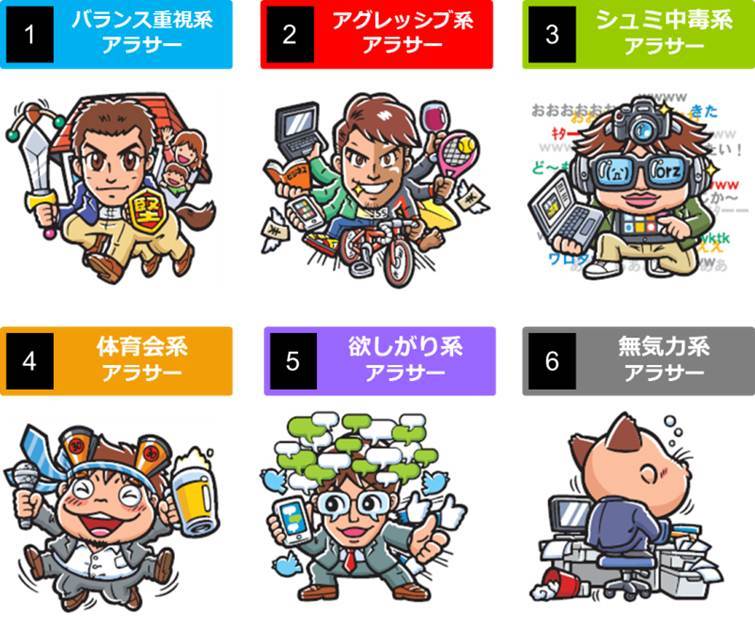In the previous column, we classified 1,000 men in their thirties (businessmen around age 30: this time, employed men aged 28 to 32) into six clusters based on the axes of "Work, Private Life, and Communication," introducing the "Balance-Oriented Thirtysomethings" and the "Sports Club-Style Thirtysomethings." This time, focusing primarily on the remaining clusters—"Aggressive Type," "Simulation Addict Type," and "Desire-Driven Type"—we introduce the characteristics and insights of each cluster.

"Aggressive Type" (11.8% of the sample)
Do you know any men in their thirties like this? They have extensive networks, are highly motivated to improve themselves, devour business books, and on their days off, they tackle demanding sports like triathlons or trail running. Their fulfilling lives are constantly shared via social media... They approach work with stoic dedication while also throwing themselves wholeheartedly into play and hobbies. That's the defining characteristic of the "Aggressive Type in Their 30s."
Today's 30-something men tend to prioritize "avoiding losses over gaining profits" – essentially, "playing it safe" – which means their consumption drive isn't as strong compared to other generations. However, the Aggressive Type 30-Something thinks, "If it's good, I'll choose it even if it's expensive." They're the type interested in high-priced items like watches and cars, as well as investments. They frequently share things they like with others and actively post on blogs and social media.
Simulation Addict Thirtysomethings (14.2% of the group)
This cluster prioritizes private life above all else. They tend to be reserved in social interactions and relatively passive in their work ethic. They desire a clear separation between private life and work, preferring a peaceful, ordinary daily routine. While price-conscious in general shopping, they are willing to spend generously on their hobbies. Consequently, financial concerns appear to be a source of future anxiety... Their ideal future self is someone with "deep knowledge in a specific field." They thrive in small, elite communities with like-minded individuals, showing little interest in trends or others' hobbies, and are reserved about sharing or disseminating information.
*The illustration depicts someone knowledgeable about digital gadgets, but the "hobbies" of this simulation-addicted thirtysomething are not limited to this field.
The "Want-It-All" Thirtysomethings (35.4% of the group)
The largest segment among 30-something men is the "Desire-Driven 30-Somethings." While not overly proactive in their careers, they harbor a shrewd desire for recognition. They are highly active in posting and sharing information on social media, spending the longest time across all clusters on platforms—whether PC or mobile—and lead lives centered around SNS, where they readily experience "connections" and "approval from others." Compared to other clusters, they also tend to prioritize appearances over honesty, place greater importance on being popular with the opposite sex than with their own, and have a tendency to put on airs. A defining characteristic of this cluster is their tendency to crave instant gratification in various areas: recognition at work, praise from friends and acquaintances on social media, approval from the opposite sex... they want it all, and they want it now.
Lethargic Thirtysomethings (4.6% of the population)
This cluster exhibits apathy toward work, personal life, and relationships, showing the lowest life satisfaction. They have unclear future visions and little material desire, resulting in very low consumption motivation. With a composition ratio of 4.6%, they represent the smallest volume among men in their thirties.
*When performing factor/cluster analysis, such a low-response segment inevitably emerges in the classification.
THINK30's analysis of 30-something male clusters: We've introduced the four clusters not covered in the previous installment.
Among the clusters introduced this time, the "Aggressive Thirtysomethings" and "Desire-Driven Thirtysomethings" are particularly striking for their high upward aspirations, the number of communities they engage with, and their information dissemination power on social media. While 30-something men share generational stories and fundamental insights, they also exhibit diverse types. Each cluster differs in consciousness, values, mental triggers, lifestyles, areas of interest, consumption behaviors, and media engagement. When developing communication strategies for products or brands targeting men around age 30, carefully engaging with these 30-something men through clustering may reveal a winning approach.
That's the story behind classifying 30-year-old men this time. But remember, research and clustering are never the final goal. At "THINK30," the project team supporting 30-year-old men, we use this as a starting point. We're actively developing strategies, creative concepts, and even products to solve challenges for clients targeting this demographic.
They work hard, succeed, fail, and find the next clue in that feedback loop. Some enjoy hanging out with friends they like, playfully interact with their wives and kids, while others hesitate about marrying their girlfriend. "Man, today's overtime was exhausting," they think, coming home from work with their suit and head smelling a bit off, but still, dinner tastes great! "Alright, let's give it our all again tomorrow." We're not trying to be pretentious. We just want to make the lives of these ordinary 30-something guys, and how they engage with society, feel a little bit better. That's our theme. We want to give these everyday, ordinary 30-something guys a chance to think: "What do I truly want to cherish? What discomforts do I want to eliminate? What is happiness for me?"
And above all, to support 30-year-old men in becoming the backbone of Japan, forging a new future, and building a new normal—I'll be cheering them on through various approaches.
By the way, what kind of 30-something men are sitting near you as you read this column?
<Analysis Overview>
Survey Areas: Kanto (Tokyo/Kanagawa/Chiba/Saitama), Kansai (Osaka/Hyogo/Kyoto/Nara), Chubu (Aichi/Gifu/Mie)
Analysis Subject: Employed men aged 28-32 (1,000 respondents)
Survey Period: Thursday, November 28, 2013 - Monday, December 2, 2013
Survey Method: Internet survey
Survey Implementation Agency: Macromill








